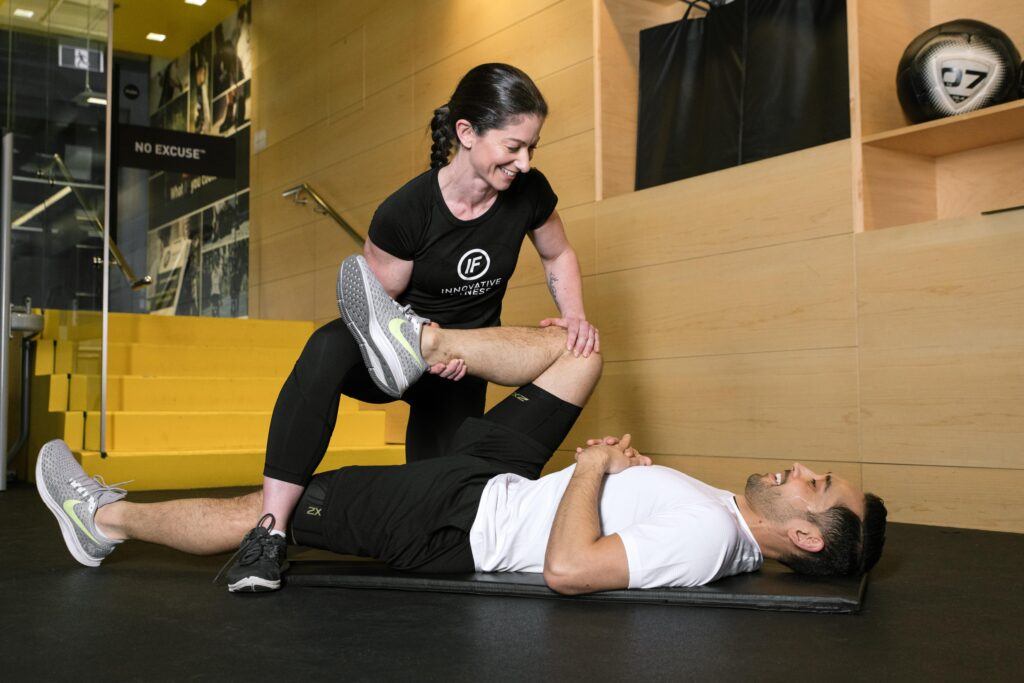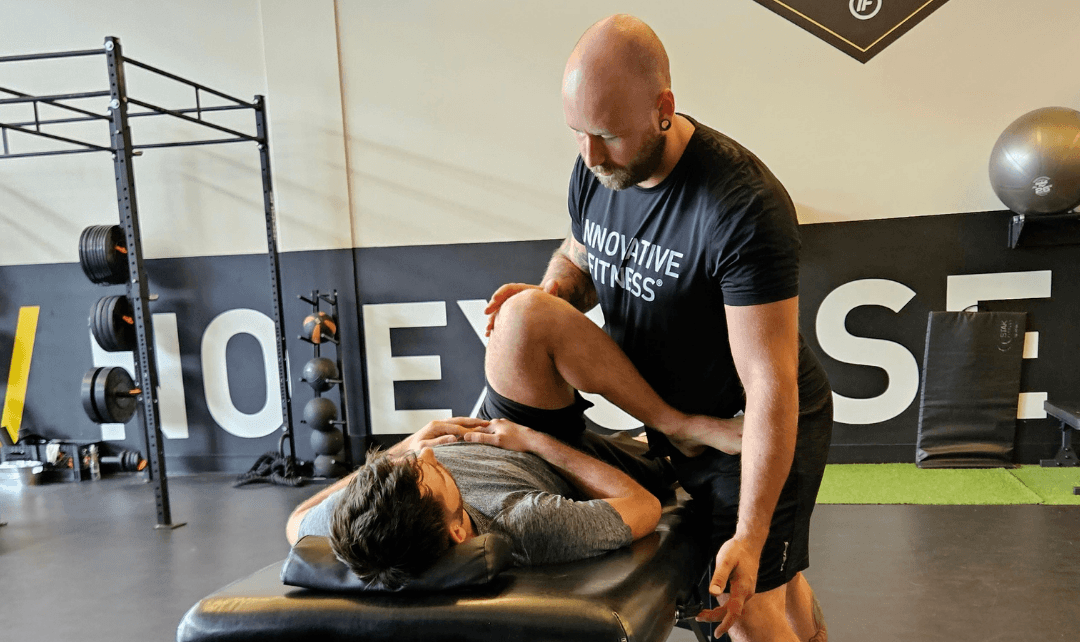Taking your body back home: The Comprehensive Guide to Fascial Stretch Therapy
In the pursuit of optimal health and fitness, people often explore various avenues to enhance their well-being. One such modern and holistic form of body work called Fascial Stretch Therapy (FST), is rapidly gaining popularity, and for good reason. This method of bodywork delivers truly impressive results, and best of all, feels amazing while you’re doing it. Clients can experience noticeable changes to areas of issue in just 5 or 10 minutes of treatment, and report results that are actually long lasting. At Innovative Fitness, we understand the importance of holistic wellness, and are proud to have FST as a cornerstone of our commitment to helping our clients achieve their health and fitness goals through next level personalized bodywork.
Firstly, what is Fascia?
Fascia is a complex, interconnected web of connective tissue that wraps around and permeates every muscle, bone, organ, and nerve fiber in the body. Often described as the body’s “scaffolding” or “organ of structure,” fascia provides support and stability while allowing for flexibility and movement. Think of it like a three-dimensional spiderweb that holds everything in place. Beyond its structural role, fascia also plays a crucial role in transmitting force and information throughout the body, contributing to our sense of proprioception and kinesthetic awareness. Fascia can become tight, restricted, or imbalanced due to factors like injury, poor posture, stress, or repetitive movements, leading to pain, stiffness, and limitations in movement. Understanding the importance of fascia is key to optimizing our overall health and well-being, as it influences everything from our posture and flexibility to our athletic performance and resilience against injury.
What are “fascial lines”?
In Thomas Myers’ groundbreaking book “Anatomy Trains,” he introduces the concept of fascial lines, revolutionizing our understanding of human anatomy and movement. Fascial lines are interconnected networks of connective tissue that span the entire body, influencing how we move and function. These lines serve as pathways for force transmission, allowing for integrated movement and coordination across multiple joints and muscles.
Myers identifies several key fascial lines, including the Superficial Back Line, which runs from the bottom of the feet, along the back of the body, to the head; the Superficial Front Line, connecting the front of the body from the toes to the skull; the Lateral Line, which encompasses the side of the body from the foot to the skull; the Spiral Line, wrapping around the body in a double helix pattern; the Deep Front Line, connecting the pelvis to the rib cage and supporting core stability; and several more. Understanding these fascial lines provides invaluable insight into movement patterns, posture, and the interconnectedness of the body as a whole. By recognizing and working with these lines, we can optimize movement efficiency, alleviate pain, and enhance overall well-being through fascial stretching techniques.
Why does taking care of our fascia matter?
Fascia plays an important role in the support and function of our bodies, since it surrounds and attaches to all structures. In the normal healthy state, the fascia is relaxed and wavy in configuration. It has the ability to stretch and move without restriction. When one experiences physical trauma, emotional trauma, scarring, or inflammation, however, the fascia loses its pliability. It becomes tight, restricted, and a source of tension to the rest of the body.
Trauma, such as a fall, car accident, whiplash, surgery or just habitual poor posture and repetitive stress injuries has cumulative effects on the body. The changes trauma causes in the fascial system influences comfort and function of our body. Fascial restrictions can exert excessive pressure causing all kinds of symptoms producing pain, headaches or restriction of motion. Fascial restrictions affect our flexibility and stability and are a determining factor in our ability to withstand stress and perform daily activities.
What is Fascial Stretch Therapy (FST)?
Fascial Stretch Therapy is a unique and effective form of table-top bodywork that targets the connective tissue, or fascia, in the body. Unlike other forms of body work that just focus on joints or muscles, FST is an immersive system that mobilizes not just musculature, but also gets deep into joints and fascial lines to achieve truly impressive increases in mobility, decreases in joint stiffness, reduction of chronic pain, and restoration of balance and alignment to the body. FST involves dynamic movements and controlled fascial stretching by your FST practitioner. Treatments are gentle, relaxing, and feel amazing, making FST a great alternative for those who do not enjoy the intense sensations of deep tissue massage.

Benefits of Fascial Stretch Therapy:
- Improved Flexibility: FST focuses on lengthening and restoring the natural elasticity of the fascia, leading to increased flexibility and range of motion.
- Pain Reduction: By releasing tension in the fascia, FST can help alleviate chronic pain, stiffness, and discomfort associated with various conditions, including muscle imbalances and postural issues.
- Enhanced Performance: Athletes and fitness enthusiasts can benefit from FST to optimize their physical performance by improving muscle function and reducing the risk of injuries.
- Stress Reduction: FST incorporates gentle, rhythmic movements and controlled breath, promoting relaxation and reducing stress. This can contribute to improved mental well-being and a better overall sense of calm, due to the down regulation of the nervous system from fight or flight (Sympathetic) to rest and recover mode (parasympathetic).
Fascial stretch therapy as a joint care system:
Something that sets FST apart from traditional forms of bodywork is its ability to target deep within our joints. FST enhances flexibility and range of motion in joints, reducing stiffness and discomfort associated with aging. Repeated treatments can also help maintain proper alignment and balance by addressing imbalances in the fascial system. FST also Improves circulation and nutrient delivery to joint tissues, promoting joint health and longevity.
The FST system alleviates tension and pressure on joints by releasing tight fascia, reducing the likelihood of degenerative conditions such as osteoarthritis. When we have better posture and biomechanics, we reduce the wear and tear on joints over time. Supporting overall mobility using this joint care model can allow older adults to maintain an active lifestyle and preserve joint function without resorting to invasive interventions like joint replacements.
Who Can Benefit from Fascial Stretch Therapy?
Fascial Stretch Therapy is suitable for individuals of all fitness levels and backgrounds. Whether you’re an athlete looking to enhance performance, someone recovering from an injury, or simply seeking to improve overall flexibility and well-being, FST can be tailored to meet your specific needs.
At Innovative Fitness, we believe in providing cutting-edge solutions to support your health and fitness journey. Fascial Stretch Therapy is a key component of our holistic approach, offering a multitude of benefits for individuals seeking to enhance flexibility, reduce pain, and optimize overall well-being. Experience the transformative effects of FST with our certified practitioners and unlock a new level of wellness at Innovative Fitness.
To learn more about Facial Stretch Therapy book your consultation at your nearest Innovative Fitness studio.






